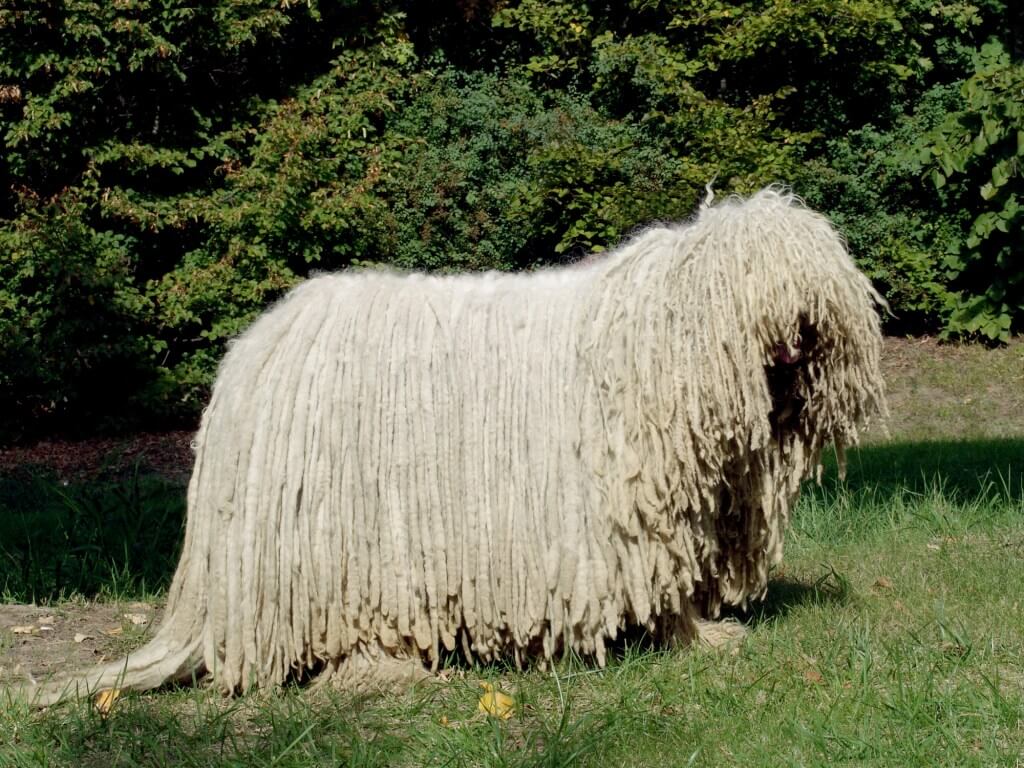Appearance
Table of Contents
With a striking white coat comprised almost entirely of long, corded locks and an impressive stature, the Komondor certainly stands out in a crowd. While their coat is certainly attractive, this dog breed’s unique coat serves several essential functions especially when the Komondor is working as a livestock guardian. When protecting sheep, the white coloring helps them to blend in with the livestock and remain unseen from predators. When the coat is fully developed, it also protects the Komondor from bites; wolves and other predators usually can’t penetrate the thick coat and reach the skin to cause serious damage. Their heavy double-coat also serves to protect them from the weather. A wooly undercoat helps insulate them and regulate body temperature while their coarse, corded overcoat prevents dirt and debris from reaching the Komondor's skin. Standing between 27 and 31 inches tall, these dogs usually weigh in from 80-130 lbs relative to their height. They have powerful and well-muscled bodies with long legs and a slightly curled tail. They have broad heads and dark eyes, complete with black nose and lip coloring. A strong, protective family companion, Komondor usually live to be between 10-12 years old.
Grooming
The coat of a Komondor goes through several stages before becoming fully formed in adulthood. As a puppy, the coat is soft and slightly curly. As they get older, the cords begin to develop into long cords with a felt-like texture and continue to lengthen as the dog matures. While the Komondor doesn’t require brushing, they do need help preventing their beautiful cords from becoming a matted mess. As the cords begin to form, follow the natural pattern and help separate the locks into ringlets to remove debris and dirt. An occasional bath will help keep them fresh and drying is an absolute must. It is important to keep the hair clean and dry since moisture that gets trapped in the coat will cause an unpleasant mildew smell. If the blow dryer is causing anxiety, many Komondor will enjoy relaxing in front of a floor fan after bath time. To help keep the Komondor’s face clean, trim the hair just around the mouth to prevent fur staining and other meal related messes. Regularly check their nails and trim if necessary to avoid any painful ingrown nails or breakage. Gently wiping out the inside of the Komondor’s ear will help to prevent infection and get rid of irritating dirt.
Temperament
Due to their high levels of intelligence, will power, and independence, the Komondor thrives with an experienced owner who isn’t afraid to take charge. The Komondor maintains puppy-like behavior for about 3 years before maturing. They are fiercely protective by nature and develop strongly devoted bonds with their families. They greatly enjoy being a part of daily family activities and won’t be happy staying outside alone for long periods of time. While they usually have a calm demeanor, they can quickly become excited and love to play. They typically get along well with other family pets and will even feel protective over them. However, the Komondor is naturally wary of strangers and will not tolerate an unknown person or animal trespassing on their property. Early socialization is key in teaching the Komondor how to appropriately respond when meeting new animals. These dogs were bred to patrol large acres of land and will not adjust well to apartment living. Even when living in an environment with ample space, daily walks are important to ensure the Komondor gets enough exercise as well as improve their socialization skills.
Training
It is vital to establish acceptable behaviors early on in puppyhood to prevent disobedience later in life. The Komondor is a highly willful breed and needs to know that their owner is the leader of the pack; otherwise, they will continue to challenge their owner and disregard commands. Training is an excellent bonding experience and will prevent destructive behaviors. A bored and non-stimulated dog, especially a puppy, will turn to their own devises for amusement. Consistently correcting unwanted behavior every time it happens is necessary in order to help the Komondor remember lessons and commands. Rewarding good behavior with positive praise or small snacks or toys will reinforce the idea that they should continue that type of conduct. Both obedience training and socialization skills should be practiced daily and kept interesting in order to improve their activities and prevent the Komondor from becoming bored.
History
The Komondor was most often utilized to guard livestock, a job they excelled at due to their temperament and appearance. Their unique coat allows them to blend in with their herd and prevent predators from realizing they are even there. While the Komondor excels at protecting their charges from harm, they aren’t often utilized as herders. Whereas other breeds help to direct and herd livestock, the Komondor typically accompanies the livestock from place to place, serving more as a guard. Originally from Hungary, reports show that this breed dates back as far as the 16th century. The Komondor of today is more of a family companion than working dog, but some can still be found out on ranches and farms diligently protecting their flock.
Other names
Hungarian Komondor, Hungarian Sheepdog, Mop Dog









